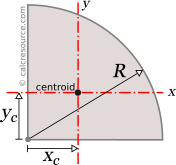

Instead we choose a polar system, with its pole O coinciding with circle center, and its polar axis L coinciding with the axis of rotation x, as depicted in the figure below. Since we have a circular area, the Cartesian x,y system is not the best option. First we must define the coordinate system. Using the above definition, which applies for any closed shape, we will try to reach to the final equation for the moment of inertia of circle, around an axis x passing through its center. Depending on the context, an axis passing through the center may be implied, however, for more complex shapes it is not guaranteed that the implied axis would be obvious.įrom the definition also, it is also apparent that the moment of inertia should always have a positive value, since there is only a squared term inside the integral.įinding the equation for the moment of inertia of a circle Often though, one may use the term "moment of inertia of circle", missing to specify an axis. Where A is the area of the shape and y the distance of any point inside area A from a given axis of rotation.įrom this definition it becomes clear that the moment of inertia is not a property of the shape alone but is always related to an axis of rotation. The second moment of area of any planar, closed shape is given by the following integral: Typical units for the moment of inertia, in metric, are: Typical units for the moment of inertia, in the imperial system of measurements are: By definition, the moment of inertia is the second moment of area, in other words the integral sum of cross-sectional area times the square distance from the axis of rotation, hence its dimensions are ^4. In fact, this is true for the moment of inertia of any shape, not just the circle.


Since those are lengths, one can expect that the units of moment of inertia should be of the type: ^4. The above equations for the moment of inertia of circle, reveal that the latter is analogous to the fourth power of circle radius or diameter. Or if you want a nearly instant answer, go straight to our calculator.The moment of inertia of circle with respect to any axis passing through its centre, is given by the following expression:Įxpressed in terms of the circle diameter D, the above equation is equivalent to: You can practice finding the moment of area by manually working out the calculations and then check your answers with our handy calculator. But the formulas will be given so if you actually need to calculate by hand, the calculator will be a great resource to check your work.įor common shapes the equations for moment of area are as follows: When determining the moment of inertia along an axis, we generally consider the “base” as the distance across the x-axis, and the “height” as the vertical distance, along the y-axis.Ĭalculating the second moment of area of geometric figures can be confusing and time consuming by hand, so let this calculator do all the work for you. When completing the calculations, the units will be to the 4th power. It is an explanation of how the area is distributed about the x-axis or the y-axis. So what exactly is the moment of inertia of plane area? The moment of inertia calculator will determine the second moment of area (also known as the moment of inertia of plane area or the area moment of inertia) of common geometric figures.īefore calculating the second moment of area, we need to understand the concept.


 0 kommentar(er)
0 kommentar(er)
